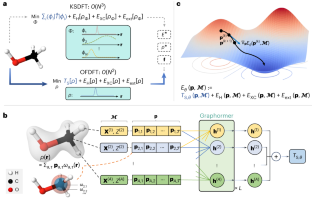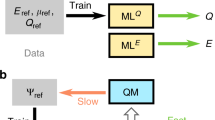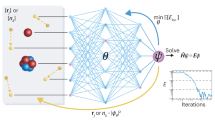Abstract
Orbital-free density functional theory (OFDFT) is a quantum chemistry formulation that has a lower cost scaling than the prevailing Kohn–Sham DFT, which is increasingly desired for contemporary molecular research. However, its accuracy is limited by the kinetic energy density functional, which is notoriously hard to approximate for non-periodic molecular systems. Here we propose M-OFDFT, an OFDFT approach capable of solving molecular systems using a deep learning functional model. We build the essential non-locality into the model, which is made affordable by the concise density representation as expansion coefficients under an atomic basis. With techniques to address unconventional learning challenges therein, M-OFDFT achieves a comparable accuracy to Kohn–Sham DFT on a wide range of molecules untouched by OFDFT before. More attractively, M-OFDFT extrapolates well to molecules much larger than those seen in training, which unleashes the appealing scaling of OFDFT for studying large molecules including proteins, representing an advancement of the accuracy–efficiency trade-off frontier in quantum chemistry.
This is a preview of subscription content, access via your institution
Access options
Access Nature and 54 other Nature Portfolio journals
Get Nature+, our best-value online-access subscription
$29.99 / 30 days
cancel any time
Subscribe to this journal
Receive 12 digital issues and online access to articles
$99.00 per year
only $8.25 per issue
Buy this article
- Purchase on Springer Link
- Instant access to full article PDF
Prices may be subject to local taxes which are calculated during checkout




Similar content being viewed by others
Data availability
All molecular structures used in this study can be freely accessed from public sources: ethanol structures are from the MD17 dataset36 at http://www.sgdml.org/#datasets, QM939 molecular structures are from https://doi.org/10.6084/m9.figshare.978904, QMugs45 molecular structures are from https://doi.org/10.3929/ethz-b-000482129, and structures of chignolin, the BBL-H142W system (PDB ID 2WXC) and the protein B system (PDB ID 1PRB) are from ref. 47 at https://www.deshawresearch.com/downloads/download_trajectory_science2011.cgi. Example evaluation data for reproducing the analyses in this work are available at https://doi.org/10.6084/m9.figshare.c.6877432 (ref. 79). Source data are provided with this paper.
Code availability
The code for implementing the proposed methodology is available at https://doi.org/10.5281/zenodo.10616893 (ref. 80). Trained neural network model checkpoints are available at https://doi.org/10.6084/m9.figshare.c.6877432 (ref. 79).
References
Seminario, J. M. Recent Developments and Applications of Modern Density Functional Theory (Elsevier, 1996).
Jain, A. et al. The Materials Project: a materials genome approach to accelerating materials innovation. APL Mater. 1, 011002 (2013).
Kohn, W. & Sham, Lu. Jeu Self-consistent equations including exchange and correlation effects. Phys. Rev. 140, A1133 (1965).
Thomas, L. H. The calculation of atomic fields. Math. Proc. Camb. Phil. Soc. 23, 542–548 (1927).
Fermi, E. Eine statistische methode zur bestimmung einiger eigenschaften des atoms und ihre anwendung auf die theorie des periodischen systems der elemente. Z. Phys. 48, 73–79 (1928).
Wang, Y. A. & Carter, E. A. Orbital-free kinetic-energy density functional theory. Theor. Methods Condens. Phase Chem. 5, 117–184 (2000).
Karasiev, V. V., Chakraborty, D. & Trickey, S. B. In Many-electron Approaches in Physics, Chemistry and Mathematics: A Multidisciplinary View (eds Bach, V. & Delle Site, L.) 113–134 (Springer, 2014).
Hodges, C. H. Quantum corrections to the Thomas–Fermi approximation—the Kirzhnits method. Can. J. Phys. 51, 1428–1437 (1973).
Brack, M., Jennings, B. K. & Chu, Y. H. On the extended Thomas–Fermi approximation to the kinetic energy density. Phys. Lett. B 65, 1–4 (1976).
Wang, L.-W. & Teter, M. P. Kinetic-energy functional of the electron density. Phys. Rev. B 45, 13196 (1992).
Wang, Y. A., Govind, N. & Carter, E. A. Orbital-free kinetic-energy density functionals with a density-dependent kernel. Phys. Rev. B 60, 16350 (1999).
Huang, C. & Carter, E. A. Nonlocal orbital-free kinetic energy density functional for semiconductors. Phys. Rev. B 81, 045206 (2010).
Hung, L. & Carter, E. A. Accurate simulations of metals at the mesoscale: explicit treatment of 1 million atoms with quantum mechanics. Chem. Phys. Lett. 475, 163–170 (2009).
Witt, W. C., Beatriz, G., Dieterich, J. M. & Carter, E. A. Orbital-free density functional theory for materials research. J. Mater. Res. 33, 777–795 (2018).
García-Aldea, D. & Alvarellos, J. E. Kinetic energy density study of some representative semilocal kinetic energy functionals. J. Chem. Phys. 127, 144109 (2007).
Xia, J., Huang, C., Shin, I. & Carter, E. A. Can orbital-free density functional theory simulate molecules? J. Chem. Phys. 136, 084102 (2012).
Teale, A. M. et al. DFT exchange: sharing perspectives on the workhorse of quantum chemistry and materials science. Phys. Chem. Chem. Phys. 24, 28700–28781 (2022).
Snyder, J. C., Rupp, M., Hansen, K., Müller, Klaus-Robert & Burke, K. Finding density functionals with machine learning. Phys. Rev. Lett. 108, 253002 (2012).
Li, L. et al. Pure density functional for strong correlation and the thermodynamic limit from machine learning. Phys. Rev. B 94, 245129 (2016).
Brockherde, F. et al. Bypassing the Kohn–Sham equations with machine learning. Nat. Commun. 8, 872 (2017).
Seino, J., Kageyama, R., Fujinami, M., Ikabata, Y. & Nakai, H. Semi-local machine-learned kinetic energy density functional with third-order gradients of electron density. J. Chem. Phys. 148, 241705 (2018).
Imoto, F., Imada, M. & Oshiyama, A. Order-N orbital-free density-functional calculations with machine learning of functional derivatives for semiconductors and metals. Phys. Rev. Res. 3, 033198 (2021).
Yao, K. & Parkhill, J. Kinetic energy of hydrocarbons as a function of electron density and convolutional neural networks. J. Chem. Theory Comput. 12, 1139–1147 (2016).
Meyer, R., Weichselbaum, M. & Hauser, A. W. Machine learning approaches toward orbital-free density functional theory: simultaneous training on the kinetic energy density functional and its functional derivative. J. Chem. Theory Comput. 16, 5685–5694 (2020).
Remme, R., Kaczun, T., Scheurer, M., Dreuw, A. & Hamprecht, F. A. KineticNet: Ddeep learning a transferable kinetic energy functional for orbital-free density functional theory. J. Chem. Phys. 159, 144113 (2023).
García-González, P., Alvarellos, J. E. & Chacón, E. Nonlocal kinetic-energy-density functionals. Phys. Rev. B 53, 9509–9512 (1996).
Mi, W., Genova, A. & Pavanello, M. Nonlocal kinetic energy functionals by functional integration. J. Chem. Phys. 148, 184107 (2018).
Kato, T. On the eigenfunctions of many-particle systems in quantum mechanics. Commun. Pure Appl. Math. 10, 151–177 (1957).
Ying, C. et al. Do transformers really perform badly for graph representation? Adv. Neural Inf. Process. Syst. 34, 28877–28888 (2021).
Shi, Y. et al. Benchmarking Graphormer on large-scale molecular modeling datasets. Preprint at https://arxiv.org/abs/2203.04810 (2022).
Vaswani, A. et al. Attention is all you need. Adv. Neural Inf. Process. Syst. 30, 6000–6010 (2017).
Smith, J. S., Isayev, O. & Roitberg, A. E. ANI-1: an extensible neural network potential with DFT accuracy at force field computational cost. Chem. Sci. 8, 3192–3203 (2017).
Schütt, K. T., Sauceda, H. E., Kindermans, P.-J., Tkatchenko, A. & Müller, K.-R. SchNet—a deep learning architecture for molecules and materials. J. Chem. Phys. 148, 241722 (2018).
Thölke, P. & De Fabritiis, G. Equivariant transformers for neural network based molecular potentials. In International Conference on Learning Representations (2021).
Liao, Y.-L. & Smidt, T. Equiformer: equivariant graph attention transformer for 3D atomistic graphs. In Eleventh International Conference on Learning Representations (2023); https://openreview.net/forum?id=KwmPfARgOTD
Chmiela, S. et al. Machine learning of accurate energy-conserving molecular force fields. Sci. Adv. 3, e1603015 (2017).
Chmiela, S., Sauceda, H. E., Poltavsky, I., Müller, K.-R. & Tkatchenko, A. sGDML: constructing accurate and data efficient molecular force fields using machine learning. Comput. Phys. Commun. 240, 38–45 (2019).
Ruddigkeit, L., Van Deursen, R., Blum, L. C. & Reymond, J-L. Enumeration of 166 billion organic small molecules in the chemical universe database GDB-17. J. Chem. Inf. Model. 52, 2864–2875 (2012).
Ramakrishnan, R., Dral, P. O., Rupp, M. & von Lilienfeld, O. A. Quantum chemistry structures and properties of 134 kilo molecules. Sci. Data 1, 140022 (2014).
Constantin, L. A., Fabiano, E., Laricchia, S. & Della Sala, F. Semiclassical neutral atom as a reference system in density functional theory. Phys. Rev. Lett. 106, 186406 (2011).
Karasiev, V. V. & Trickey, S. B. Issues and challenges in orbital-free density functional calculations. Comput. Phys. Commun. 183, 2519–2527 (2012).
von Weizsäcker, C. F. Zur theorie der kernmassen. Z. Phys. 96, 431–458 (1935).
Hirshfeld, F. L. Bonded-atom fragments for describing molecular charge densities. Theor. Chim. Acta 44, 129–138 (1977).
Sun, Q. et al. PySCF: the Python-based simulations of chemistry framework. Wiley Interdiscip. Rev. Comput. Mol. Sci. 8, e1340 (2018).
Isert, C., Atz, K., Jiménez-Luna, José. & Schneider, G. QMugs, quantum mechanical properties of drug-like molecules. Sci. Data 9, 273 (2022).
Du, Y., Li, S., Tenenbaum, J. & Mordatch, I. Learning iterative reasoning through energy minimization. In International Conference on Machine Learning 5570–5582 (PMLR, 2022).
Lindorff-Larsen, K., Piana, S., Dror, R. O. & Shaw, D. E. How fast-folding proteins fold. Science 334, 517–520 (2011).
Neuweiler, H. et al. The folding mechanism of BBL: plasticity of transition-state structure observed within an ultrafast folding protein family. J. Mol. Biol. 390, 1060–1073 (2009).
Wang, T., Zhu, Y. & Gai, F. Folding of a three-helix bundle at the folding speed limit. J. Phys. Chem. B 108, 3694–3697 (2004).
Rayson, M. J. & Briddon, P. R. Rapid iterative method for electronic-structure eigenproblems using localised basis functions. Comput. Phys. Commun. 178, 128–134 (2008).
VandeVondele, J. et al. QUICKSTEP: fast and accurate density functional calculations using a mixed Gaussian and plane waves approach. Comput. Phys. Commun. 167, 103–128 (2005).
Govind, N., Wang, Y. A., Da Silva, A. J. R. & Carter, E. A. Accurate ab initio energetics of extended systems via explicit correlation embedded in a density functional environment. Chem. Phys. Lett. 295, 129–134 (1998).
Zhao, W. X. et al. A survey of large language models. Preprint at https://arxiv.org/abs/2303.18223 (2023).
Zheng, S. et al. Towards predicting equilibrium distributions for molecular systems with deep learning. Preprint at https://arxiv.org/abs/2306.05445 (2023).
Krondorfer, J. K., Binder, C. W. & Hauser, A. W. Symmetry- and gradient-enhanced Gaussian process regression for the active learning of potential energy surfaces in porous materials. J. Chem. Phys. 159, 014115 (2023).
Chen, Y., Zhang, L., Wang, H. & Weinan, E. DeePKS: a comprehensive data-driven approach toward chemically accurate density functional theory. J. Chem. Theory Comput. 17, 170–181 (2021).
Kirkpatrick, J. et al. Pushing the frontiers of density functionals by solving the fractional electron problem. Science 374, 1385–1389 (2021).
Li, L. et al. Kohn–Sham equations as regularizer: building prior knowledge into machine-learned physics. Phys. Rev. Lett. 126, 036401 (2021).
Dunlap, B. I. Robust and variational fitting. Phys. Chem. Chem. Phys. 2, 2113–2116 (2000).
Bardo, R. D. & Ruedenberg, K. Even-tempered atomic orbitals. VI. Optimal orbital exponents and optimal contractions of Gaussian primitives for hydrogen, carbon, and oxygen in molecules. J. Chem. Phys. 60, 918–931 (1974).
Han, J. et al. Deep potential: a general representation of a many-body potential energy surface. Commun. Comput. Phys. 23, 629–639 (2018).
Li, H. et al. Deep-learning density functional theory Hamiltonian for efficient ab initio electronic-structure calculation. Nat. Comput. Sci. 2, 367–377 (2022).
Li, F., Fujiwara, K., Okura, F. & Matsushita, Y. A closer look at rotation-invariant deep point cloud analysis. In Proc. IEEE/CVF International Conference on Computer Vision 16218–16227 (IEEE, 2021).
Puny, O. et al. Frame averaging for invariant and equivariant network design. In International Conference on Learning Representations (2022); https://openreview.net/forum?id=zIUyj55nXR (2022).
Schütt, K., Unke, O. & Gastegger, M. Equivariant message passing for the prediction of tensorial properties and molecular spectra. In International Conference on Machine Learning 9377–9388 (PMLR, 2021).
Batzner, S. et al. E(3)-equivariant graph neural networks for data-efficient and accurate interatomic potentials. Nat. Commun. 13, 2453 (2022).
Fazlyab, M., Robey, A., Hassani, H., Morari, M. & Pappas, G. Efficient and accurate estimation of Lipschitz constants for deep neural networks. Adv. Neural Inf. Process. Syst. 32, 11427–11438 (2019).
Amari, S. Natural gradient works efficiently in learning. Neural Comput. 10, 251–276 (1998).
Yoshikawa, N. & Sumita, M. Automatic differentiation for the direct minimization approach to the Hartree–Fock method. J. Phys. Chem. A 126, 8487–8493 (2022).
Hoffmann, R. An extended Hückel theory. I. Hydrocarbons. J. Chem. Phys. 39, 1397–1412 (1963).
Wang, J. et al. Machine learning of coarse-grained molecular dynamics force fields. ACS Cent. Sci. 5, 755–767 (2019).
McGibbon, R. T. et al. MDTraj: a modern open library for the analysis of molecular dynamics trajectories. Biophys. J. 109, 1528–1532 (2015).
Eastman, P. et al. OpenMM 7: rapid development of high performance algorithms for molecular dynamics. PLoS Comput. Biol. 13, e1005659 (2017).
Case, D. A. et al. Amber 10 Technical Report (Univ. California, 2008).
Ho, G. S., Lignères, V. L. & Carter, E. A. Introducing PROFESS: a new program for orbital-free density functional theory calculations. Comput. Phys. Commun. 179, 839–854 (2008).
Enkovaara, J. et al. Electronic structure calculations with GPAW: a real-space implementation of the projector augmented-wave method. J. Phys. Condens. Matter 22, 253202 (2010).
Mi, W. et al. ATLAS: a real-space finite-difference implementation of orbital-free density functional theory. Comput. Phys. Commun. 200, 87–95 (2016).
Shao, X., Jiang, K., Mi, W., Genova, A. & Pavanello, M. DFTpy: an efficient and object-oriented platform for orbital-free DFT simulations. Wiley Interdiscip. Rev. Comput. Mol. Sci. 11, e1482 (2021).
Zhang, H. et al. Overcoming the barrier of orbital-free density functional theory in molecular systems using deep learning. figshare https://doi.org/10.6084/m9.figshare.c.6877432 (2024).
Zhang, H. et al. Overcoming the barrier of orbital-free density functional theory in molecular systems using deep learning. Zenodo https://doi.org/10.5281/zenodo.10616893 (2024).
Acknowledgements
We thank P. G. Giorgi, W. C. Witt, S. Ehlert, Z. Wang, L. Cheng, J. Hermann and Z. Liu for insightful discussions and constructive feedback; X. He and Y. Min for suggestions on protein preprocessing; H. Yang for help with trying other OFDFT software; Y. Shi for suggestions and feedback on model design and optimization; and J. Bai for helping with figure design. We received no specific funding for this work. H.Z., S.L. and J.Y. did this work during an internship at Microsoft Research AI4Science.
Author information
Authors and Affiliations
Contributions
C.L. led the research under the support from N.Z. and B.S. C.L. is the lead contact. C.L., S.Z. and B.S. conceived the project. S.L., C.L., H.Z. and J.Y. deduced and designed data generation methods, enhancement modules, training pipeline and density optimization. H.Z., S.Z. and J.Y. designed and implemented the deep learning model. H.Z. and S.L. conducted the experiments. Z.L. and T.W. contributed to the experiment design and evaluation protocol. C.L., H.Z., S.L. and S.Z. wrote the paper with input from all authors.
Corresponding authors
Ethics declarations
Competing interests
C.L., S.Z. and B.S. have filed a patent on M-OFDFT (application number: PCT/CN2023/112628). The other authors declare no competing interests.
Peer review
Peer review information
Nature Computational Science thanks Andreas Hauser and the other, anonymous, reviewer(s) for their contribution to the peer review of this work. Peer reviewer reports are available. Primary Handling Editor: Kaitlin McCardle, in collaboration with the Nature Computational Science team.
Additional information
Publisher’s note Springer Nature remains neutral with regard to jurisdictional claims in published maps and institutional affiliations.
Supplementary information
Supplementary Information
Supplementary Text, Figs. 1–19 and Tables 1–9.
Source data
Source Data Fig. 2
Statistical source data.
Source Data Fig. 3
Statistical source data.
Source Data Fig. 4
Statistical source data.
Rights and permissions
Springer Nature or its licensor (e.g. a society or other partner) holds exclusive rights to this article under a publishing agreement with the author(s) or other rightsholder(s); author self-archiving of the accepted manuscript version of this article is solely governed by the terms of such publishing agreement and applicable law.
About this article
Cite this article
Zhang, H., Liu, S., You, J. et al. Overcoming the barrier of orbital-free density functional theory for molecular systems using deep learning. Nat Comput Sci 4, 210–223 (2024). https://doi.org/10.1038/s43588-024-00605-8
Received:
Accepted:
Published:
Issue Date:
DOI: https://doi.org/10.1038/s43588-024-00605-8
This article is cited by
-
Pushing the limits of OFDFT with neural networks
Nature Computational Science (2024)



